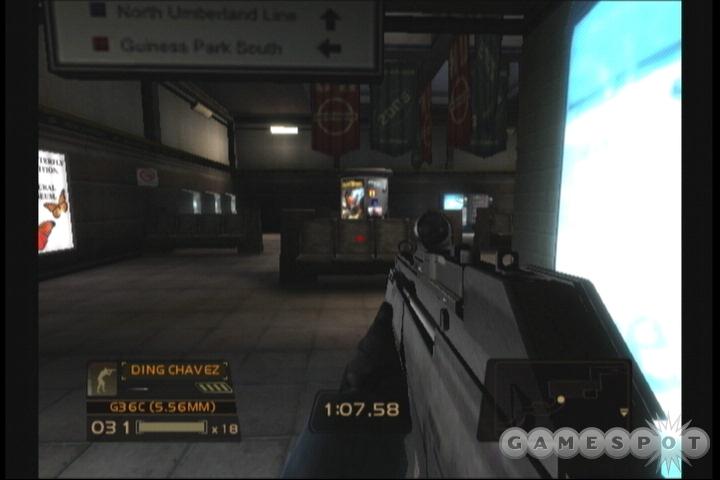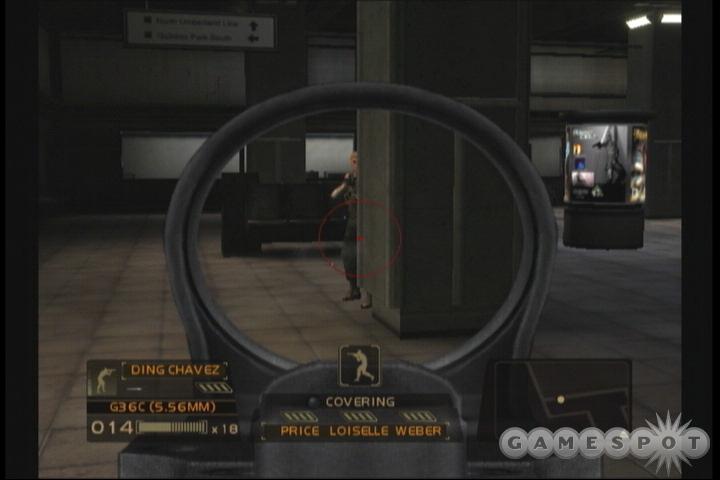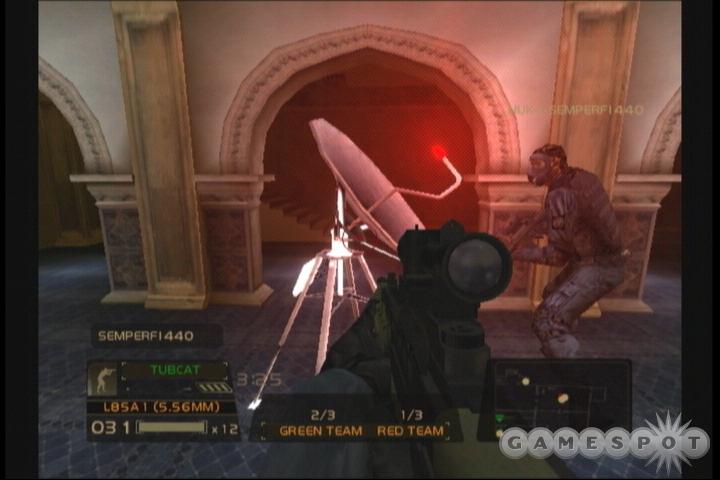Less than a year ago, Ubisoft successfully brought the Rainbow Six series of realistic tactical shooters to the Xbox with Tom Clancy's Rainbow Six 3. The game was so successful, in fact, that it's already begotten a sequel of sorts in Tom Clancy's Rainbow Six 3: Black Arrow, a follow-up that offers a hefty amount of new content without any major changes to the gameplay. Black Arrow will be instantly appealing to anybody who enjoyed the original game, since it includes a slew of new maps, a few new weapons and multiplayer modes, and some other slight refinements. And since the game is built on such a winning and accessible formula, it makes a great place to start for newcomers, too.

If you have played Rainbow Six 3 for any length of time, you can skip to the next page to proceed to what's new. For the uninitiated, Black Arrow (like its precursor) puts you in the shoes of Domingo "Ding" Chavez, a longtime Tom Clancy character and the leader of the crack antiterrorist force Team Rainbow. Along with your international squadmates Eddie Price, Louis Loiselle, and Dieter Weber, you'll be tasked with creeping your way through a linear progression of missions that are located in hotspots around the world. You're basically tasked with taking out terrorists, defusing bombs, rescuing hostages, and generally fighting the good fight against the forces of evil.
Black Arrow features an all-new single-player campaign composed of 10 new maps, which are set in a mixture of everyday environments (a subway, a hotel, the streets of Milan) and industrial or military installations (a nuclear reactor, a rocket facility). These maps are well crafted in essentially the same style as those of the previous game, with tight corridors, wide-open spaces, and, most importantly, lots of cover for both you and the bad guys to hide behind.
The single-player portion of Black Arrow, like Rainbow Six 3 before it, is as much about telling your teammates how, when, and where to shoot the terrorists as it is about you shooting them yourself. The designers of the original game devised an elegant method of issuing commands, despite the limitations of the Xbox controller, and that method is identical here. Essentially, you can give the most basic, context-sensitive commands by simply pointing and tapping a button. For instance, if you want your team to move to a certain position, you just aim your crosshairs at that location, hit the button, and away they go. Your teammates will also do a fairly good job of defending themselves should they be assaulted by enemies; however, as in Rainbow Six 3, both your allies and your opponents will sometimes act in less-than-intelligent fashions, which can include sometimes running straight into opposing fire. Nevertheless, most of the game's shoot-outs that involve computer-controlled characters play out quite believably.
There's more to squad management than point-and-click, however. More-complex commands can be given by holding down the same button, which pops up a menu that can be used, in conjunction with the directional pad, to have your team do things like breach a locked door so that the room can be cleared of hostiles. Issuing one of these orders "on zulu" will let you have the team ready itself to execute the action on command so that you can have them go in one direction while you try to flank the enemy from another. As in the previous game, you can optionally use an Xbox Live headset to verbally give your teammates commands, which is (obviously) much more hands-free than using the controller. This scheme does work pretty well, as far as voice recognition goes. As action-oriented as Black Arrow is, it's also a surprisingly complex and rewarding tactical experience, since the careful consideration and execution of your orders will get you through a given situation much more smoothly than simply running in, guns ablaze. In fact, this will usually get you killed.

Even though you can have your team do the majority of the work, you'll want to do plenty of the shooting yourself--because, hey, that's the fun part. You'll get to choose your weapons and equipment loadout before a mission starts, drawing from a large assortment of rifles, sidearms, grenades, and so on. All of these are real-world weapons, and most of them return from the previous game, with a few notable exceptions. The deadly .50-caliber rifle that many players felt dominated Rainbow Six 3's multiplayer modes has been removed. In its place are two more-standard (and more-sensible) sniper rifles: the Dragunov and the PSG-1. You'll get a basic briefing before each mission that will detail your objectives and help you tailor your weapons selection to the situation, although sometimes it's easier to try the mission out once to see exactly what you need before going back to pick new armament.
The actual shooting action in the game is identical to Rainbow Six 3's, which had a truly excellent feel to it. In fact, Black Arrow owes everything--from the sounds of its guns, to its accurate models, to its solid game controls, to its subtle implementation of rag-doll physics (which make enemies drop in heaps when hit by well-aimed shots)--to its predecessor. One of the best and most unique features of both games' shooting interfaces involves the targeting reticle, which (contrary to other such games) actually gets bigger as your precision increases, such as when you're standing still, crouched, or looking down your weapon's sights. This gives you a tangible perception of where to aim to hit an enemy, since anyone that falls inside the circle will take a hit. It's a minor innovation that really helps to enhance the action in the game, especially since controlling a first-person view with a thumbstick is sometimes an imprecise affair, made all the more so by unclearly implemented auto-aim systems.
The core 10-mission, single-player campaign in Black Arrow is solid and well built. The missions also pack replay value in that you can revisit them with different weapons and at different difficulty settings to make for a challenging and tense shoot-out each time. But the single-player options are only the beginning of what the game has to offer. Rainbow Six 3 had a similar campaign that was just as good, but what really kept players coming back for months afterward was the game's superb Xbox Live support, which has been at least matched, if not exceeded, in Black Arrow.

For starters, there's a slew of multiplayer maps, many of which are new (though a few return from the previous game). Last time around, there was already a bevy of competitive and cooperative multiplayer gameplay modes on offer, all of which return here. Mission mode simply has you playing the same missions from the single-player game but with other players, while terrorist hunt uses the same maps but tasks you with simply killing all the terrorists and not worrying about other goals. These two modes are quite a bit of fun, because it can be especially rewarding to work together as a team against artificially intelligent baddies--especially with real-time voice communication over the headset.
Among the returning competitive multiplayer modes are survival and team survival, where everyone fights it out to see who can stay alive the longest. In addition, there's a sharpshooter mode, which is essentially the game's deathmatch mode. However, Black Arrow really ups the competitive ante with two substantial new modes: total conquest and retrieval. Total conquest already appears to be emerging as the fan favorite, because it's a team-based mode in which both sides vie for control of three satellite transmitter stations that are scattered around the map. To control one, you have to run up and claim it for a few seconds and then defend it from attackers. Victory is based on one team controlling all three points for a set amount of time. The retrieval mode is similar to the standard capture the flag of many other games, with one notable difference: there's only one flag (actually, in this case it's a biohazard canister). Each team will race to secure the canister from a point on the map, and then it will run the canister back to its own disposal site to score a point, all while fending off opposing forces. Both of these new modes gives you more depth than the previous game, and both represent very welcome additions to Black Arrow's multiplayer loadout.
It shouldn't be hard to find a game online, either. There were plenty of sessions to try out online as of the very day the game was released. Many of these featured the new team conquest and retrieval game types, so it seems as though dedicated fans of Rainbow Six 3 are taking to the new modes quickly. It's worth noting that many of the games we encountered were being run by hardcore players affiliated with competitive Rainbow Six 3 clans, so our presence (as a potential newbie) was not always desired. So you may want to ally yourself with an existing group of players if you want to make sure you always have someone to play with or against. Fortunately, Black Arrow makes this easier than ever, since it's one of the first games to support Xbox Live 3.0 features. You'll easily be able to send and receive messages (both text and voice), keep track of the last two dozen players you played with, form your own squad, or simply look for others who are currently recruiting. It's safe to say that Black Arrow has one of the most complete multiplayer implementations--at least from an interface standpoint--that we've seen in a console game.
As if all that weren't enough, Black Arrow has a feature that was found in the PS2 and GameCube ports of Rainbow Six 3 but not in the Xbox original: split-screen cooperative support. You and another player can negotiate any of the single-player missions as a two-man team, which is about as straightforward a process as you would expect. There aren't any serious performance hits here either, which is nice. You don't get to see your weapon models and the detail seems reduced a tad, but otherwise it's basically the same experience. The split-screen support is a welcomed alternative to system link if you only have one copy of the game and want to try a little cooperative play with a friend. Don't expect to be able to play cooperatively online, though.
When Rainbow Six 3 came out late last year, it looked great on the Xbox. In turn, the easiest way to describe Black Arrow's graphics is to say that they're, well, pretty much identical. That is to say, the scenery is different, but the quality is pretty much equivalent. Your squadmates will look pretty familiar, because they're still here in all their highly detailed glory. Additionally, the maps are clean and functional, with a reasonable number of set pieces and some nice effects (like curtains blowing in the wind) to enhance the realism. Graphical standards have been raised on the Xbox since Rainbow Six 3 was released, but even next to better-looking games on the same system, Black Arrow still looks quite impressive. And the weapon models still stand out as some of the best in the business.

The audio also remains basically unchanged from the previous game, so you'll hear all of the same gunfire and Team Rainbow voice samples that you're familiar with. But these were terrific in Rainbow Six 3, so Ubisoft essentially hasn't messed with success. The guns are really worth mentioning, since they sound highly realistic and pack a serious punch, which is only enhanced if you use a 5.1 home theater setup. Just as powerful are some of the game's grenades. In fact, you'll seriously jump when one goes off unexpectedly in your face. There's little music to speak of (except for some stirring militaristic melodies in the menus), because the sounds of combat are all the score this game needs. Aside from this, the in-game voice work is well done and helps to set the tone of the missions.
All around, Rainbow Six 3: Black Arrow is a great package that builds on the framework that was laid out by the original game. The worst thing you can say about this release is that it's essentially the same game as Rainbow Six 3, but since its predecessor was exceptional, is that really such a bad thing? Black Arrow retails for less than most new Xbox games, thus making it a good value for fans of Rainbow Six 3 who want to get more of what they loved the first time around. It's also one of the most complete online-enabled console shooters around.